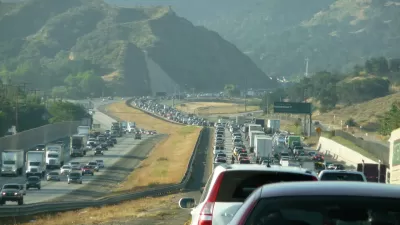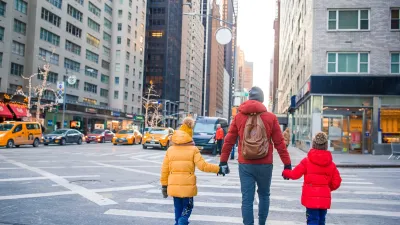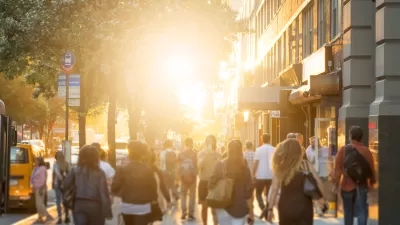Classical liberal commentator F.A. Hayek argued that monomaniacal government planning would eventually lead to limits on individual freedom—and government hostility to pedestrians may be an example of this.

In "The Road to Serfdom," F.A. Hayek wrote, "Individual freedom cannot be reconciled with the supremacy of one single purpose to which the whole of society is permanently subordinated." Hayek was of course thinking about economic planning designed to govern society as a whole. However, his thoughts could just as easily be applied to transportation and land use policy; at all levels of government, 20th-century American land use and transportation planners sought to support "one single purpose to which the whole of society is permanently subordinated"—making cars go as fast as possible. For example, American planners bulldozed city neighborhoods to build highways so that cars could go from downtown to suburbs as rapidly as possible, widened existing roads so that cars could move as rapidly as possible, and limited density everywhere because of concerns about traffic congestion.
Much has been written about whether these policies have achieved their goals; however, it seems to me that even if car-oriented policies have reduced congestion, they may have also led to restrictions on the freedom of nondrivers.
Here’s why: after a few decades of car-oriented policies, driving inevitably became the norm in most of the United States. This alone need not, in theory, restrict the freedom of nondrivers.* However, once driving became the norm, politicians, police officers and prosecutors inevitably began to see walking as abnormal or even dangerous, and as a result have begun to limit pedestrians’ liberty in the name of security.
A very early manifestation of this mentality was anti-jaywalking statutes; in the 1920s, the automobile lobby and its allies persuaded state and local politicians to enact statutes outlawing something called "jaywalking"—that is, walking anywhere except at certain portions of the street (that is, intersections). Even at intersections, pedestrians can only cross streets for a few seconds at a time. Americans supported these statutes because they thought without these limits, pedestrians would not be safe from speeding cars.**
By contrast, drivers have the entire street at their disposal. In the most car-dominated places, police have gone beyond fining pedestrians for this offense; in some places, pedestrians have been arrested for jaywalking, and in others, they have been treated even more harshly. For example, if you are walking with a child at the wrong place or time and the child is hit by a car, you may be prosecuted for manslaughter, on the theory that your jaywalking caused the crash. If your jury is comprised of people who drive everywhere and view walking as abnormal and dangerous, your chances of acquittal are probably not very good.
On the other hand, police (many of whom spend lots of time in cars) and prosecutors tend to treat errant drivers leniently; as long as the state cannot prove a driver did not kill a pedestrian intentionally or after drinking copious amounts of alcohol, a driver who kills a pedestrian is unlikely to receive significant punishment in some jurisdictions. Less serious violations of traffic law are treated even less seriously by government and by the public; for example, I suspect that nearly every American who drives a car violates speed limits on a fairly regular basis.
Jaywalking statutes do at least allow walkers to cross some streets at some points. However, some government officials have gone even further in keeping minor pedestrians off the streets. If government officials view walking as dangerous, a logical step is to limit minors' access to this activity. And most states have created perfect tools for such limitations, by enacting vague laws prohibiting "neglect" or "endangerment" or children. In some places, if you let your child walk (or even play) outside and anyone sees the child present without you, you can be arrested (and possibly even lose your child) for this offense, if the nearest police officer believes that a child alone is in more danger than a child in her parents’ vehicle.
In the United States, automobile dependence has become a slippery slope. Auto-philic planners may have originally believed that they were increasing Americans’ freedom by enabling them to drive faster—but today, many Americans are serfs to their cars, because government limits their right to walk in a variety of ways.
*I note, however, that the growth of automobile-dependent sprawl also indirectly reduces individual freedom by (1) making it difficult and expensive for people to reach jobs and other important destinations without purchasing a car and (2) designing streets that are so wide as to be hazardous for pedestrians. However, these impacts are less direct and coercive than the harms discussed above.
**As I wrote some months ago on this blog, it is not clear to me that this is always the case.

Alabama: Trump Terminates Settlements for Black Communities Harmed By Raw Sewage
Trump deemed the landmark civil rights agreement “illegal DEI and environmental justice policy.”

Study: Maui’s Plan to Convert Vacation Rentals to Long-Term Housing Could Cause Nearly $1 Billion Economic Loss
The plan would reduce visitor accommodation by 25% resulting in 1,900 jobs lost.

Planetizen Federal Action Tracker
A weekly monitor of how Trump’s orders and actions are impacting planners and planning in America.

Wind Energy on the Rise Despite Federal Policy Reversal
The Trump administration is revoking federal support for renewable energy, but demand for new projects continues unabated.

Passengers Flock to Caltrain After Electrification
The new electric trains are running faster and more reliably, leading to strong ridership growth on the Bay Area rail system.

Texas Churches Rally Behind ‘Yes in God’s Back Yard’ Legislation
Religious leaders want the state to reduce zoning regulations to streamline leasing church-owned land to housing developers.
Urban Design for Planners 1: Software Tools
This six-course series explores essential urban design concepts using open source software and equips planners with the tools they need to participate fully in the urban design process.
Planning for Universal Design
Learn the tools for implementing Universal Design in planning regulations.
Caltrans
Smith Gee Studio
Institute for Housing and Urban Development Studies (IHS)
City of Grandview
Harvard GSD Executive Education
Toledo-Lucas County Plan Commissions
Salt Lake City
NYU Wagner Graduate School of Public Service





























